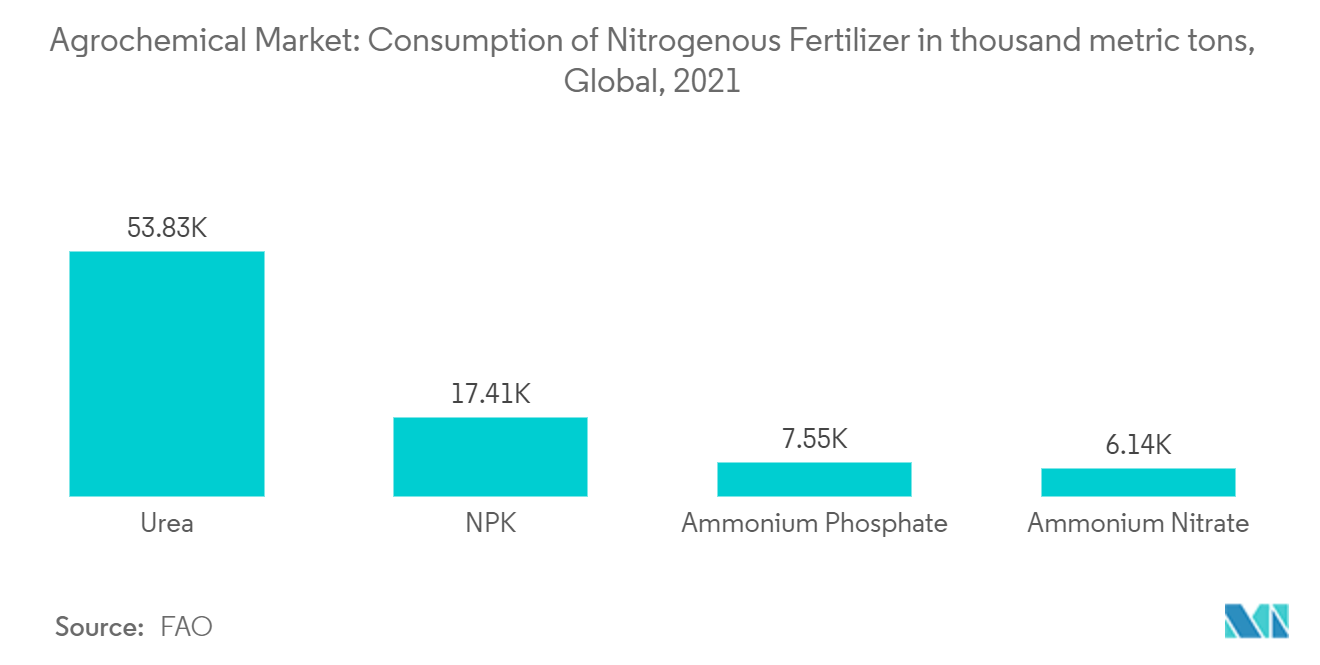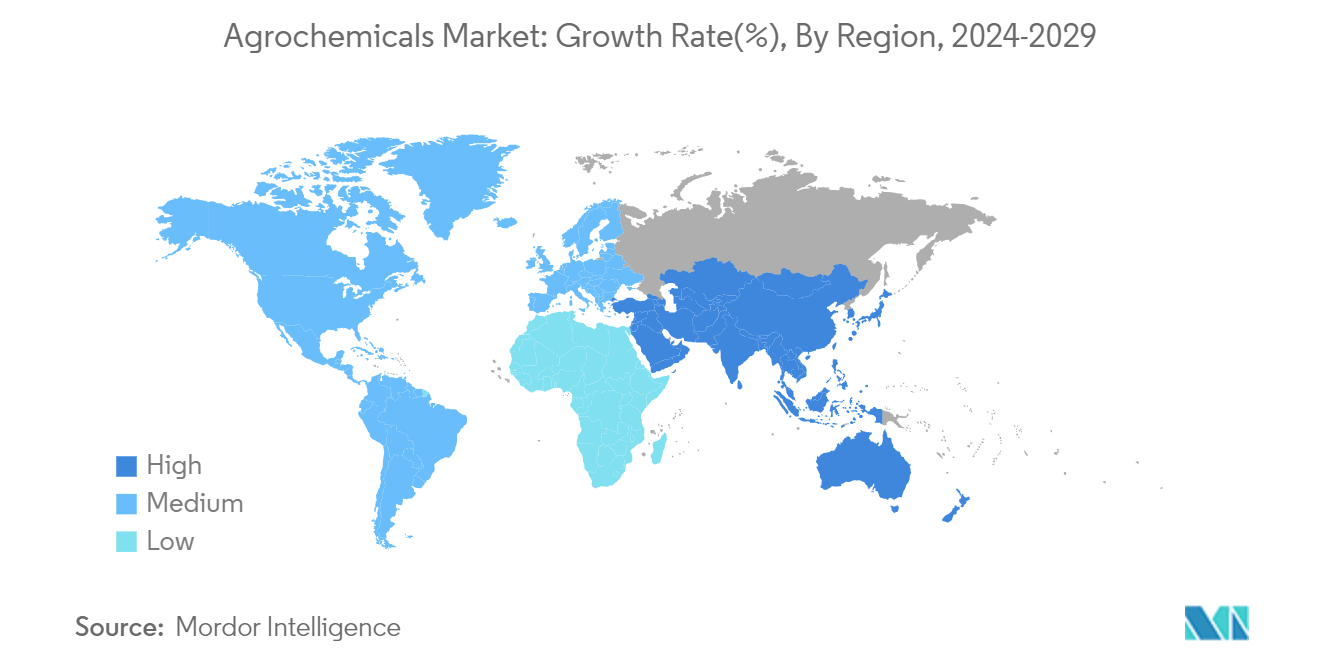Market Trends of Agrochemicals Industry
Fertilizer is the Largest Growing Product Type
The global food consumption rate rises almost ten times faster than local production. The demand for food is growing in most countries despite the slowdown induced by the decline in commodity prices. The global demand for food is projected to more than double by 2050, driven by population growth, rising incomes, rapid urbanization, and changes in regional diets toward greater consumption of higher-value fresh and processed foods. That, in turn, creates new opportunities for farmers and propels the growth of fertilizers in agriculture.
According to FAO, the world population is projected to reach 9 billion by 2050. The increasing population creates a huge demand for food products to feed the population, which is turning into a major challenge with the decreasing farmland. For instance, in 2021, approximately 17.23 million hectares of land in the United Kingdom was classified as the utilized agricultural area, which decreased from 17.27 million hectares in 2020. The shrinking area under agriculture is anticipated to demand more produce from the available land.
However, the increasing need for food security within an expanding population and greater demand from a rising middle class for food variety necessitate the need to boost crop yields, thus driving the demand for fertilizers among farmers.
Additionally, fertilizers are essential in obtaining high yields as these are necessary to increase productivity in the field. Fertilizers are vital to crop growth, showing improved performance and noticeable results. Supplying adequate plant nutrients is essential for healthy growth as well as the production capacity of plants. The nutrient demand varies with crops and soil. These nutrient demands can be effectively fulfilled through the use of chemicals. For instance, urea provides 46% nitrogen to the soil, whereas organic fertilizers like neem cake could provide only 2-5% nitrogen, an essential element for plant growth and development. Thus, to increase productivity from the limited land, the efficient use of inputs is mandatory, driving the fertilizers market as fertilizers are an important input in crop production.
According to the FAO, the NPK fertilizer agricultural use increased by 3.02% in 2019-2020. Nitrogen was the most used fertilizer in 2019, accounting for 417 thousand metric tons. Nitrogen fertilizers are the most consumed fertilizer in Africa. According to the International Fertilizers Association, the total NPK consumption in 2019 accounted for 6,605 thousand metric tons. However, usage remains well below the global average and significantly beneath the targets set by regional governments and intergovernmental organizations despite recent growth in both sales and production. For instance, according to the Africa Fertilizers Organization report, 14 fertilizer manufacturing plants were mapped in 2020. There were 151 fertilizer plants in Africa in 2020, including 87 processing plants, 15 organic plants, and 35 new facilities apart from the manufacturing plants. Malawi accounts for only two fertilizer processing plants, and Zambia has four, whereas Mozambique has five processing plants, one of which was established during the historic period in 2020. Thus, with the increased crop production, the fertilizer market has grown and is anticipated to grow further, with a preference for organic fertilizers for sustainable development.
Furthermore, more than 11% of the world’s fertilizers are supplied by Canada. In the past few years, the Canadian government has also taken several steps to promote sustainable fertilizer production in the country. Under current circumstances, Canada aims to improve fertilizer production and consumption scenario while maintaining environmental harmony. For instance, in July 2022, Canada's Minister of Agriculture and Agri-Food announced a CAD 1,685,858 investment in Sulvaris in Calgary, Alberta, for the further development of Sulvaris' carbon control technology, which produces high-efficiency fertilizers made with organic carbon.

Asia-Pacific is the Largest Segment in the Market
China accounts for the largest share of the agrochemicals market globally. Due to the decreasing cropland area, Chinese consumption of organic N, P, and K fertilizers is decreasing. For instance, according to the China Green Food Development Center, in 2021, approximately 9.84 million hectares of farmland had been certified as organic farmland in China, which has decreased from 13.9 million hectares in 2019. The cropland area under fruits and vegetables is increasing, while the area under cereals is decreasing.
Furthermore, according to the Australian Bureau of Statistics, farmers reportedly spend USD 180 million each year controlling pest infestation in their farms to produce more and enhance the country's sector growth. Also, according to Safe and Effective Pesticide Applications (SEPA), more than 8000 pesticide products are formally registered for use in Australia, and around 75% of these are used for agricultural purposes. The Australian government heavily invests in research and development to increase crop production efficiency and pest management. For instance, the Australian government provided Plant Health Australia with USD 600,000 in 2020 to address critical gaps in national research and development identified in a national workshop.
Similarly, the large production of cereal crops, like rice and wheat, in India is the major factor supporting the market's growth. The use of pesticides is rising steadily in India. Revenues of a few leading pesticides and agrochemical companies as of June 2022 were a clear indication of the growth of the agrochemical market in the country and the region.
The government of India has been constantly adopting practices that have been advantageous in augmenting the accessibility and utilization of agrochemicals in India. According to FAO, in 2022. India accounts for 15.3% of the World’s consumption of (N), 19 % (P), and 14.4% (K), owing to the large production of cereal crops, like rice and wheat in India. In spite of ranking as the second-largest nitrogenous fertilizer producer and third-largest phosphatic fertilizer producer in the world, the demand-supply gap of fertilizers in India is increasing continuously. It is leading to increased dependency on fertilizer imports.
In addition, UPL is the leading pesticides and agrochemical company in India based on net sales worth over INR 164 billion (USD 1.98 billion) as of June 2022. The company was followed by BASF India, which ranked in second place with net sales of roughly INR 130 billion (USD 1.57 billion). Data reveals that only eight states account for more than 70.0% of the total pesticide consumption in India. With a growing emphasis on the environment and sustainability, various governments in the region are enforcing clean production and environment-friendly agriculture policies, which may lead to a decline in synthetic pesticide usage in the country. However, the government has encouraged the use of microbial pesticides, which are projected to grow rapidly in the coming years.


